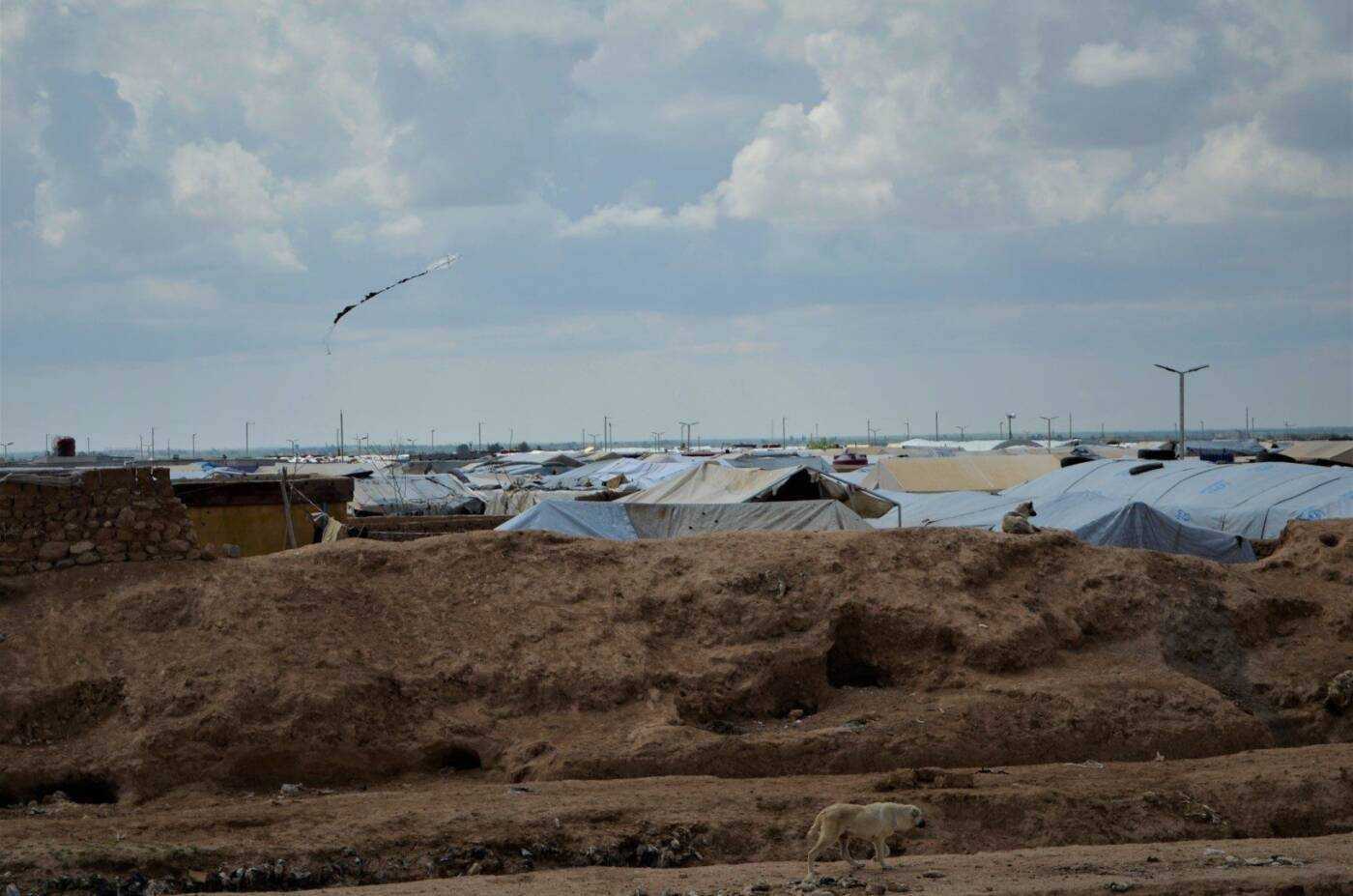Built on disputed land, a Syrian IDP camp faces an uncertain future
Abu Khashab camp was established in 2017 on agricultural land lent to local authorities by a prominent family from the area. But the land has since been claimed by another family, who never agreed to turn it into a camp. Three years later, legal deadlock persists, stalling some aid programs.
16 May 2023
ABU KHASHAB – Strolling confidently along the green edge of the sandy road curling around Abu Khashab camp in Syria’s northeastern Deir e-Zor province, Dhiab al-Jelat surveys his family’s surrounding fields. Green stems of rainfed barley stretch out as far as the eye can see, loaded with ripening ears bending in the April wind.
A storm is brewing, but al-Jelat—a tall and sturdy man with a tan face and youthful, dark beard—seems undisturbed by the drops of rain splattering the dusty road.
“I would have liked to invite you for tea on my land,” al-Jelat says in a bellowing voice, gesturing towards the camp—an expanse of white tarps and mud-brick walls crowded behind a mud enclosure. “After all, I’m already hosting over 11,000 guests,” he adds, bursting into loud laughter.
Al-Jelat claims to own the 40 hectares of land in the countryside of Deir e-Zor province on which Abu Khashab, an internal displacement camp, was established in late 2017. Thousands of civilians fleeing various hotspots of active conflict, wound up here, in the northernmost corner of the province, which had just been seized from the Islamic State (IS) by the Syrian Democratic Forces (SDF), a military coalition of Kurdish, Arab and other parties.
When the civilian counterpart of the SDF, known today as the Autonomous Administration of North and East Syria (AANES), started to look for a suitable spot for these families, al-Jelat offered to host them temporarily on a patch of land he said he inherited from his grandfather.
But in early 2020, the Brikhan family—Armenian Christians who fled Deir e-Zor after the rise of IS—contacted the administration of the camp. They claimed the land was theirs, and that Abu Khashab was built on it without their consent.
Over the past three years, the case has descended into legal deadlock. The land’s true ownership remains unclear, which has created uncertainty around the future of the camp and had a chilling effect on some humanitarian actors. In all its complexity, the unresolved story of Abu Khashab illustrates many of the legal challenges faced not only by humanitarian organizations working in northeastern Syria—where conflicts around property rights abound—but also by local property owners, both present and displaced.
Temporary camps, lingering losses
When Abu Khashab camp started to form in late 2017, it was to be a temporary gathering place for thousands of mostly Syrian and Iraqi families fleeing the countryside of Deir e-Zor. They fled their homes for a variety of reasons, including persecution by the Syrian regime and IS. The area of the camp was a stopping point between Deir e-Zor and SDF-controlled areas located further north, which people generally perceived as safer.
“Time has passed, and the land has suffered”
In the years that followed, Abu Khashab mushroomed into a large displacement camp. Today, it hosts around 11,000 people whose prolonged presence has taken a toll on the 40 hectares of rainfed farmland lying underneath. The fields were cleared, replaced by tents and then by mud houses. Concrete latrine blocks were erected, and concrete-lined open-air sewers dug. The soil was compacted and covered with a thick layer of gravel to prevent flooding and facilitate the movement of water trucks.
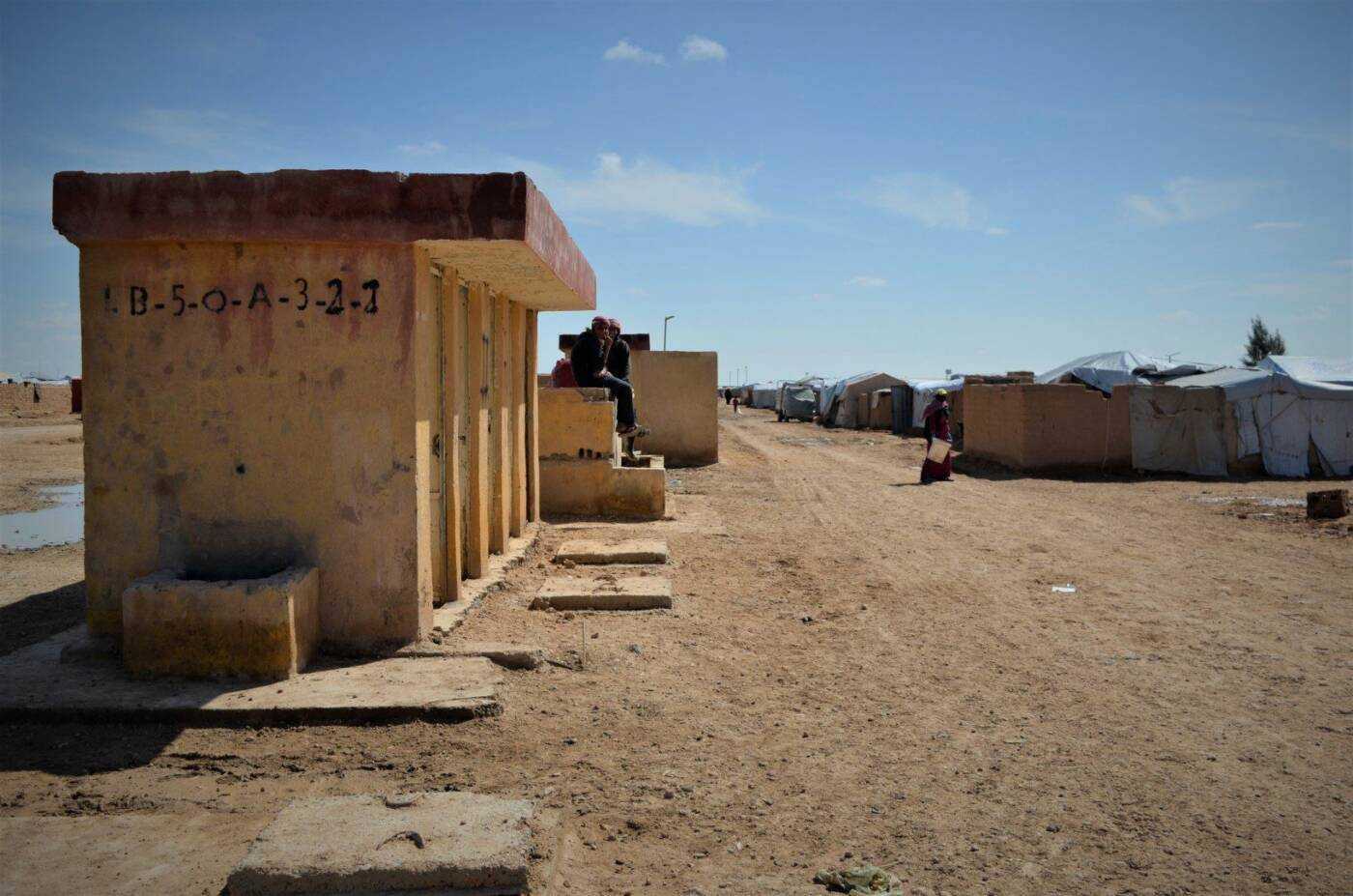
A latrine block in Abu Khashab camp, Deir e-Zor, 13/4/2023 (Lyse Mauvais/Syria Direct)
“Time has passed, and the land has suffered,” al-Jelat says, pointing to the barley fields surrounding the camp. “Look around you: this was good, fertile land. But it’s become unsuitable for agriculture.” Al-Jelat estimates that in the year 2019 alone—which was a record harvest for barley thanks to abundant rains—he could have reaped around 16 tons of barley from the land on which the camp sits. This constitutes a lost harvest worth around SYP 1.6 million ($2,666 according to the June 2019 exchange rate of around 600 SYP to the dollar).
“A lot of the camps that were built in northeastern Syria are not closing anytime soon”
Displacement camps are, by their very nature, not designed to become permanent settlements. But like Abu Khashab, they often last for years, leaving a lasting impact on the land on which they are built.
“A lot of the camps that were built in northeastern Syria are not closing anytime soon,” a foreign humanitarian worker with an international NGO active in northeastern Syria told Syria Direct. She asked not to be named due to the low-visibility policy of her organization. “If there’s agriculture, buildings or otherwise usable land, people who own the land may be losing access to this source of income,” she added.
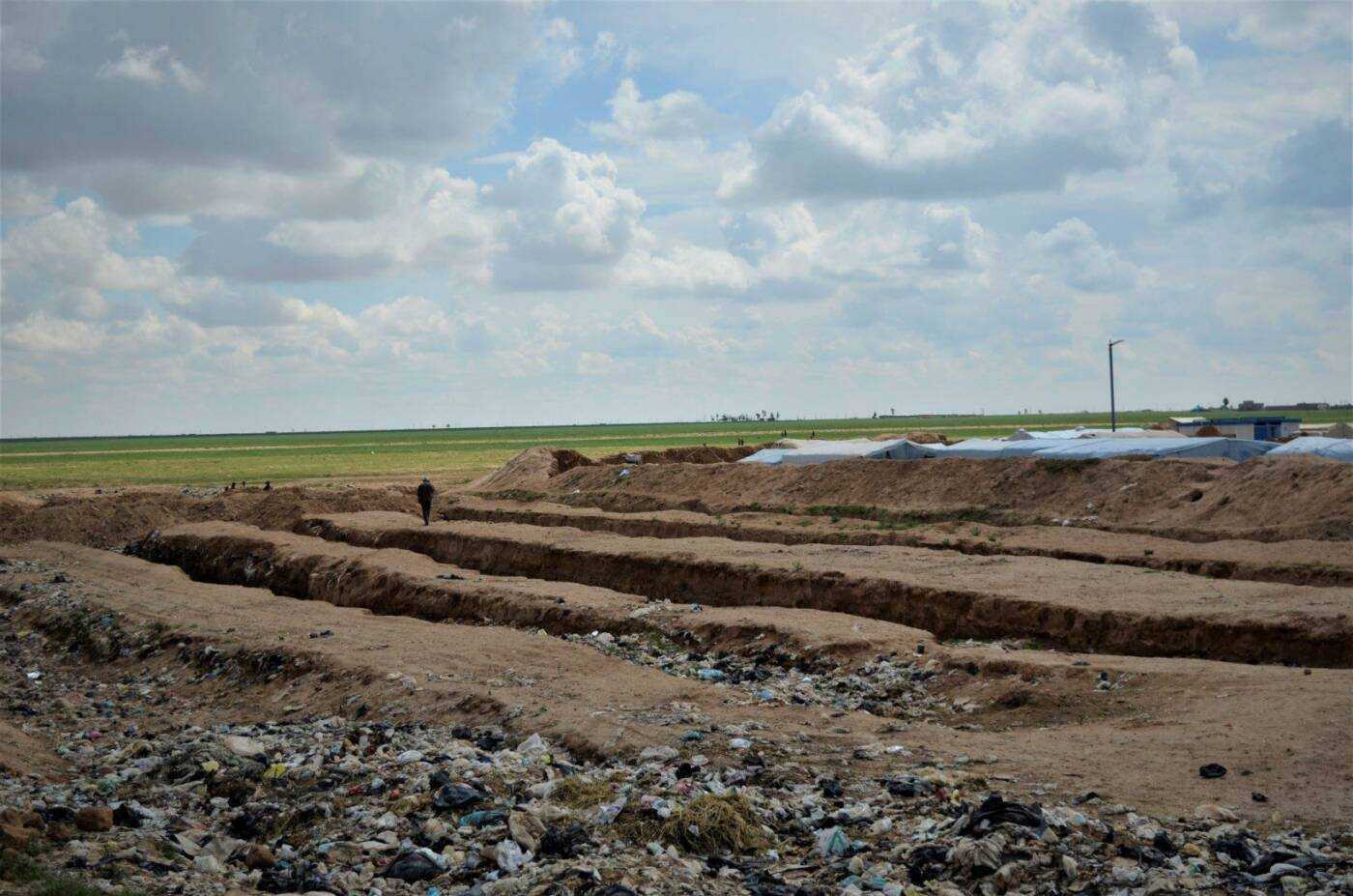
An informal landfill on the outskirts of Abu Khashab, surrounded by barley fields, 13/4/2023 (Lyse Mauvais/Syria Direct)
To avoid some of the legal complexities of dealing with private, often multiple, owners—camps are established, whenever possible, on public land lent by local authorities. Of northeastern Syria’s nine formal displacement camps, four sit on wholly public land, and two others on a mix of public and private land. The remaining camps, Abu Khashab, Tal al-Saman and Newroz, are entirely built on private land. All three face issues related to property rights, ranging from disputes about who owns the land to disagreements over rightful compensation for owners.
Legal deadlock
The dispute over Abu Khashab emerged at the beginning of 2020, more than two years after the camp was created. It has proven impossible to resolve since, due to a host of legal and political challenges.
“When the camp formed, the AANES got verbal permission to use this land from the owner of the land, who was present here in this area,” Ahmad al-Sheikh, the head of the AANES-affiliated camp administration, told Syria Direct, referring to al-Jelat. “But then, we discovered that there was a second owner, who also had papers that prove the land is theirs.” By then, it was of course too late to consider moving the camp.
The second person claiming ownership of the camp is Samig Brikhan, an Armenian Christian whose family fled Syria during the war. According to him, the land on which Abu Khashab was built belonged to his father and uncle, who are now deceased. “We were the only Christians around Abu Khashab,” Brikhan told Syria Direct. “But we haven’t been able to go back to this area since my father’s death in 2011.”
In late 2017, Brikhan’s relatives got word that humanitarian organizations were building “shelters” on their land. Brikhan, who now lives in Armenia, said he did not know who to contact to claim his land back. Back then, the security situation was too volatile to pay a visit to the camp.
“The only person left in Syria who could represent us is my aunt, who lives in Aleppo and needs special papers to travel to this area,” Brikhan said. “Since 2020, she’s been going to the camp every few months to try to meet anyone responsible. But no one helped us. The humanitarian organizations said we have to deal with the Kurdish government,” he added, referring to the AANES.
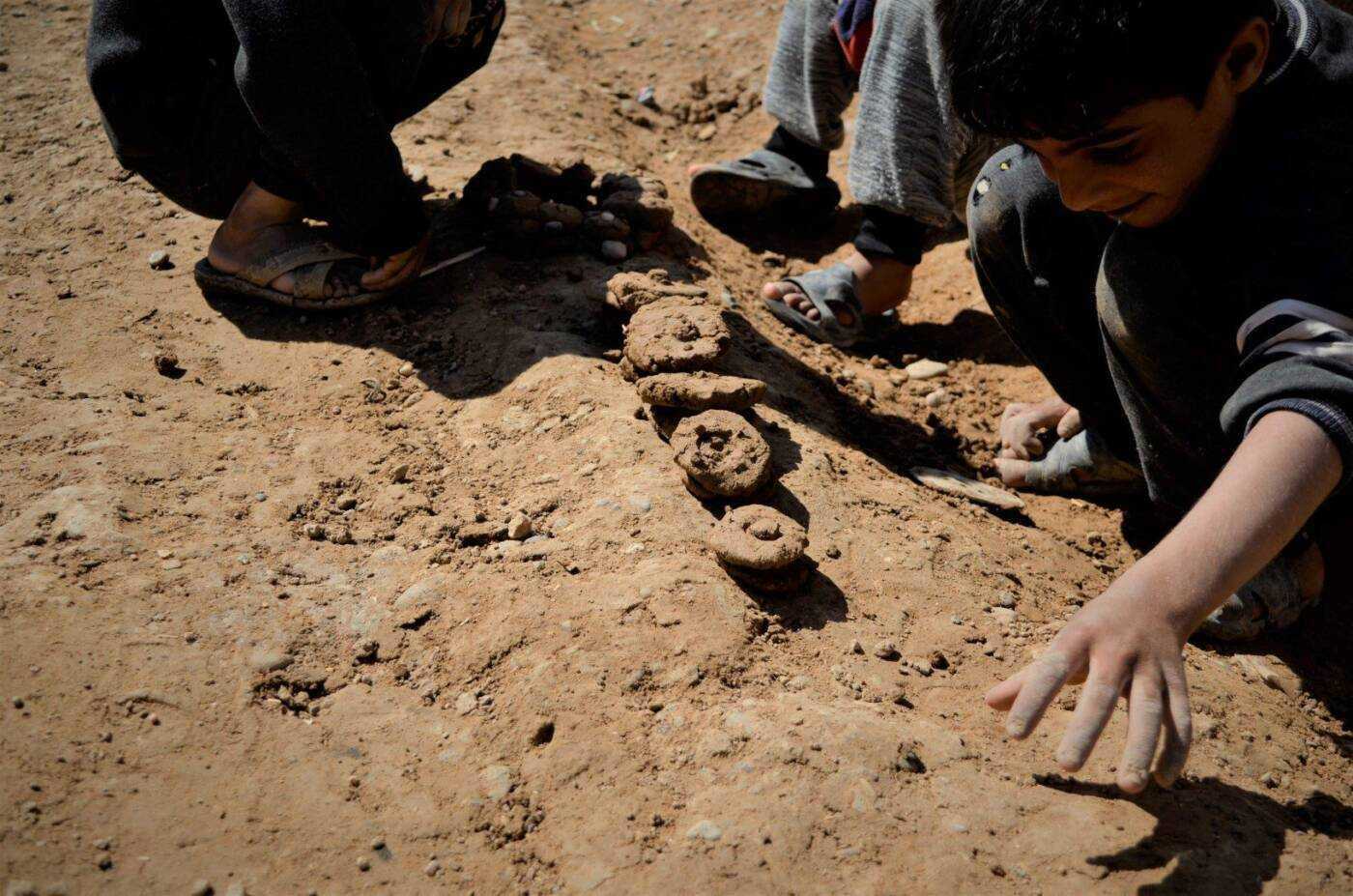
Children make toys out of mud in Abu Khashab camp, 13/4/2023 (Lyse Mauvais/Syria Direct)
Local authorities have been unwilling or unable to assert which of the two competing families has the rights to the land. And the case may be stalled by political considerations: The Jelats, who gave the AANES verbal permission to use the land in 2017, are a prominent family from Deir e-Zor known to own vast swathes of land in the north of the province, including most of the fields that surround the camp. They belong to the Baggara, an influential Arab tribe in the area, with whom the AANES has long tried to build ties in order to strengthen its hold in rural Deir e-Zor. Dhiab al-Jelat is also a local political figure, a member of the AANES’ General Council (the equivalent of a parliament) and an employee of the AANES’ Executive Council in Deir e-Zor.
The Brikhans, meanwhile, have been farming in the area around Abu Khashab since the 1950s. They have several property deeds to the land on which Abu Khashab was built that were issued by the Syrian government before the 2011 revolution. But they are members of an ethnic and religious minority that largely left Deir e-Zor during the war, and have less local influence than the Jelats.
Al-Jelat and Brikhan both provided copies of their respective ownership documents to Syria Direct, who submitted them to an independent lawyer for review. However, since Abu Khashab camp does not appear in the land registry and the location of some of the land mentioned in the documents is unclear, the lawyer could not assess the value of the two documents.
Both families are seeking formal recognition of their right to the land from local authorities, and some form of compensation for the harvests lost due to the presence of the camp.
Hindered aid
With the property dispute unresolved, rising legal uncertainty surrounding the future of the camp has hindered some NGOs’ ability to operate there.
“Many of the NGOs that want to implement projects in this camp are put off from doing so, because it’s not clear who owns the land,” al-Sheikh says. “So we hope the council will find a solution to the issue of land ownership as soon as possible, because NGOs are canceling their projects in the camp.”
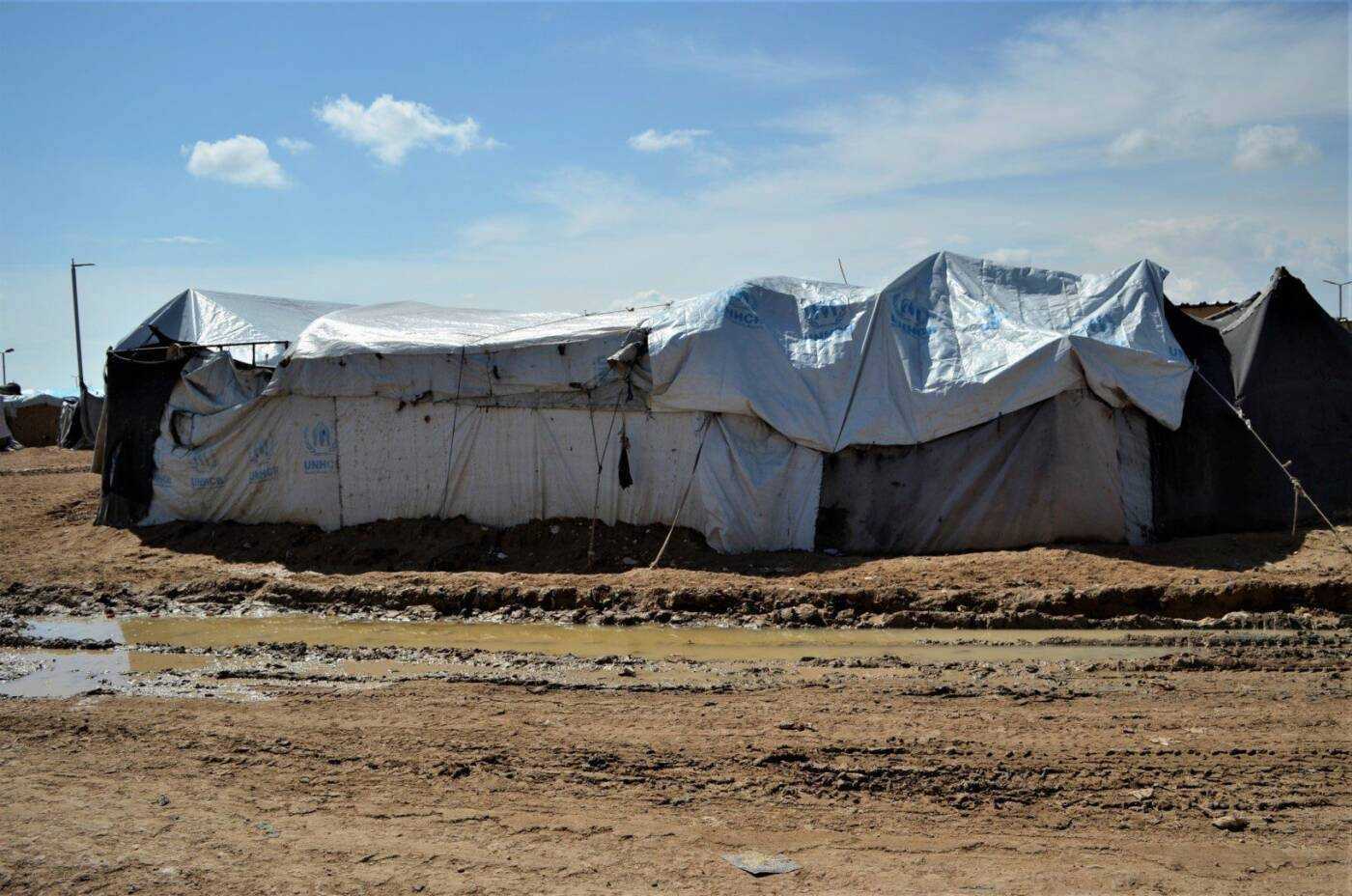
Shelters made with UNHCR tarps and mud brick walls in Abu Khashab camp, 13/4/2023 (Lyse Mauvais/Syria Direct)
The actual impact of the crisis on humanitarian activities is difficult to ascertain because most international NGOs have strict low-visibility policies and do not publicize their activities in Syria. Contacted by Syria Direct, the camp management agency—the international NGO responsible for coordinating all humanitarian intervention in Abu Khashab—declined to comment on the property dispute and its impact on NGOs in the camp.
“Until this is resolved, they don’t want to be responsible.”
However, Syria Direct was able to confirm that at least one humanitarian organization decided not to intervene in the camp due to this issue. “They were exploring working in Abu Khashab but because of these issues the project never started,” the foreign humanitarian worker said. “The NGO’s position is that until this is resolved, they don’t want to be responsible.”
Until a formal agreement is reached between the true owner and the AANES-affiliated camp administration, the camp’s existence has no legal basis. This is a challenge for some NGOs, which could be taken to court locally for intervening in the camp against the owner’s will. More generally, humanitarian actors avoid working in contexts where property rights are in dispute, in line with the principle to “do no harm” and avoid entrenching any rights violations.
According to internal documents belonging to various NGOs seen by Syria Direct, the Abu Khashab dispute has also stalled opportunities to carry out some improvements to camp infrastructure that would require the approval of the landowner. A 2020 project to install new latrines was put on hold, and other upgrades considered to be “significant disturbances” to the land, like digging new drainage networks, have also been suspended until further notice.
But a bigger threat looms: the risk that hundreds of families could be evicted from the camp by the legitimate owner.
These issues compound broader challenges related to diminishing funding for camps across northeastern Syria, which has already taken a toll on Abu Khashab. “Since 2020 humanitarian activities have decreased, with many projects discontinued,” al-Sheikh said regretfully.
But a bigger threat looms: the risk that hundreds of families could be evicted from the camp by the legitimate owner, once their rights are recognized in court. To the relief of humanitarian actors, so far none of the families involved in the dispute have requested to move the camp or suspend humanitarian activities there, but it remains a legal risk.
Looking for solutions
The Abu Khashab property dispute has remained frozen since the Brikhan family came forward in 2020 to claim ownership of the land. Although one international NGO specialized in property rights reviewed all legal documentation pertaining to the case and found that the bulk of it supports the Brikhans’ claim, the case has not yet been sorted out in court.
“We, as the camp administration, don’t know who is right,” al-Sheikh said. “We brought the case to the Civil Council in Deir e-Zor, hoping they would resolve the issue, to no avail.”
The Deir-ez-Zor Civil Council, in turn, opened a legal investigation through the main AANES court in Qamishli, which is ongoing. Contacted by Syria Direct, multiple representatives of the AANES’ Departments of Humanitarian Affairs in both Deir e-Zor and in northeast Syria declined to comment on the case.
But even if the council were to issue a legal opinion in favor of one of the two owners, it could still be contested by the other party, given the legal landscape in northeastern Syria where two legal systems coexist.
Although most of the region is controlled by the SDF, pockets of territory are still held by the Syrian regime, and government courts continue to operate there. But as the de-facto government managing most of the area, the AANES has also developed its own parallel network of courts and institutions.
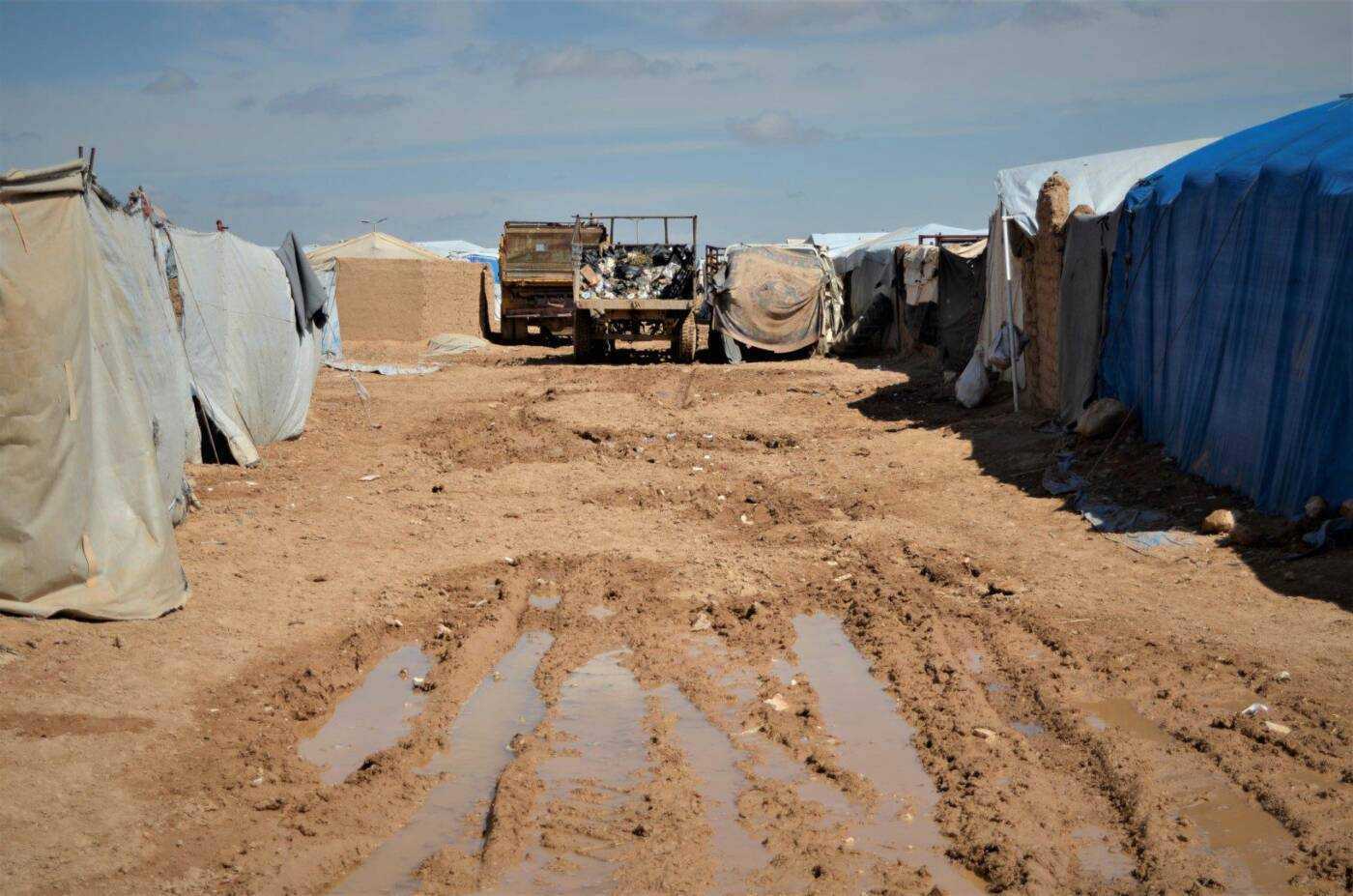
A waste collection truck in Abu Khashab camp, 13/4/2023 (Lyse Mauvais/Syria Direct)
“In similar cases, the ideal situation is to reach an agreement with the owners and to understand what they want.”
The dispute in Abu Khashab is particularly entrenched. In several other camps that have faced property disputes, solutions have been found in the past through mediation between the rights-holders and the AANES.
“In most camps, [local authorities and NGOs] have been able to find a solution,” the foreign humanitarian worker said. “In similar cases, the ideal situation is to reach an agreement with the owners and to understand what they want once we have clarity on who owns that land. Ideally, you get a memorandum of understanding with the local authorities, with the camp administration, maybe with camp management. In some cases the owners just want recognition that ‘this is my land,’ that the local authorities do recognize that. In some cases, small amounts of rent are being paid, and this is what some people want.”
But this would only be possible in Abu Khashab once ownership of the land is recognized by all parties.
“The situation in Abu Khashab is particularly concerning, because it shows a clear preference for one ‘owner’ over another, when the bulk of legal evidence indicates that the other person is the legitimate owner of the land,” the foreign humanitarian worker said.
The fact that one of the parties belongs to a minority group that was persecuted and displaced by IS and may have lost their property as a result of that displacement is also worrisome. “Because we are not there, no one defends us,” Brikhan said. Failure to process their claim transparently and impartially would send a negative signal to other displaced communities and absentee landowners who have left property behind in northeastern Syria.
In the meantime, those living in the camp continue to suffer the consequences of this legal deadlock: stalled improvements to camp infrastructure and uncertainty about their future. “We came here because the AANES put us here,” al-Sheikh, himself a resident of the camp, said. “As the camp administration and as camp residents, we don’t have any solution.”
* This report was updated on June 5, 2023 to reflect comments from Samig Brikhan. Al-Jelat and Brikhan also provided copies of their respective documents to Syria Direct after this report was first published, and it has been updated to reflect this information.

